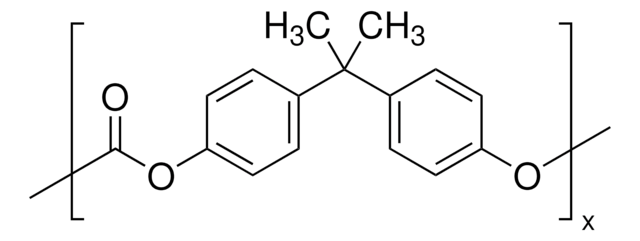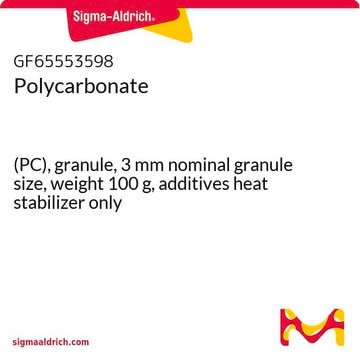About This Item
Recommended Products
Assay
95%
mp
90-92 °C (lit.)
storage temp.
2-8°C
SMILES string
CC(C)(c1ccc(OC(Cl)=O)cc1)c2ccc(OC(Cl)=O)cc2
InChI
1S/C17H14Cl2O4/c1-17(2,11-3-7-13(8-4-11)22-15(18)20)12-5-9-14(10-6-12)23-16(19)21/h3-10H,1-2H3
InChI key
MMWCQWOKHLEYSP-UHFFFAOYSA-N
Related Categories
General description
Application
- in the preparation of novel electro-optic (EO) polycarbonates containing two different kinds of nonlinear optical (NLO) chromophores with tricyanofurane (TCF) electron acceptor
- in the preparation of novel fluorine-containing poly(carbonate-block-siloxanes)
- as coupling reagent in the synthesis of block-copolymers containing poly(2,6-dimethyl-1,4-phenylene oxide) (PPO) and polycarbonate of bisphenol A (PC) segments
Signal Word
Danger
Hazard Statements
Precautionary Statements
Hazard Classifications
Acute Tox. 3 Oral - Eye Dam. 1 - Skin Corr. 1B
Storage Class Code
6.1A - Combustible acute toxic Cat. 1 and 2 / very toxic hazardous materials
WGK
WGK 3
Flash Point(F)
Not applicable
Flash Point(C)
Not applicable
Personal Protective Equipment
Certificates of Analysis (COA)
Search for Certificates of Analysis (COA) by entering the products Lot/Batch Number. Lot and Batch Numbers can be found on a product’s label following the words ‘Lot’ or ‘Batch’.
Already Own This Product?
Find documentation for the products that you have recently purchased in the Document Library.
Customers Also Viewed
Our team of scientists has experience in all areas of research including Life Science, Material Science, Chemical Synthesis, Chromatography, Analytical and many others.
Contact Technical Service












